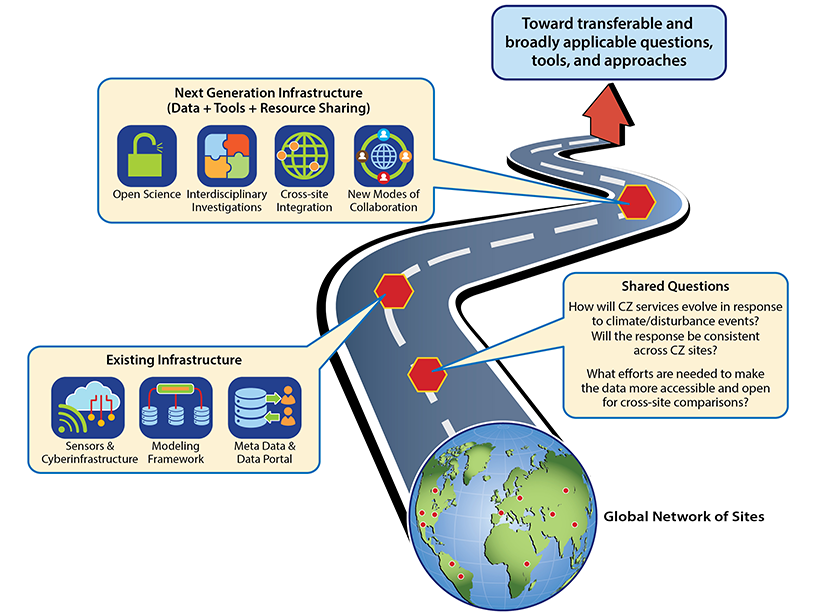Critical zones and watersheds are “human habitats,” important for sustaining basic human needs such as water, food, and energy as well as providing crucial ecosystem services. To safeguard these interests, several long-term critical zone (CZ) observatories and watershed sites have been established throughout the world, including in Canada, China, France, Germany, the United Kingdom, and the United States.
CZ observatories and watershed sites provide a multi-faceted and multidisciplinary approach to observation of the Earth’s surface throughout the extent of the critical zone.
While these CZ observatories and watershed sites may vary in their specific design, regional setting, or high priority science questions, a common feature is that they each provide a multi-faceted and multidisciplinary approach to observation of the Earth’s surface throughout the extent of the critical zone.
Additionally, a shared challenge for CZ scientists is to understand and predict how ecosystem services and “human habitats” may change with changing environmental conditions as well as rapidly growing population, urbanization, industrialization, and irrigation for food production.
A systematic approach to tackle these challenges is needed, with future efforts decreasing the fragmentation of individual CZ observatories and watershed sites as well as openly sharing data, models, and tools. Such integration across CZ sites needs to occur beyond individual networks, across disciplines and scales, and with applicability, transferability, and implications for critical zones and watersheds across the world.
To advance modes of collaboration across these networks, an international cohort of early career scientists hosted AGU workshops in 2019 and 2020. The workshop committee and participants were tasked with identifying common critical zone research priorities, capabilities, and resources, and a shared vision for a future collaborative program. Attendees recognized how networks of CZ observatories and watershed sites have resulted in novel findings and scientific insights that have shaped Earth science over the last few decades but have also generated new challenges.
The path forward should include more holistic, cross-disciplinary studies that aim to advance our understanding of critical zone systems.
These new challenges are mainly focused on developing, evaluating, and utilizing concepts, data, methods, and insights from many disciplines, sites, and networks in unique ways. The CZ path forward should include more holistic, cross-disciplinary studies that aim to advance our understanding of critical zone systems in response to environmental, technological, and societal changes, and build the next generation of tools that are broadly applicable and transferable.
Studies are beginning to develop flexible and interoperable tools that can access data from multiple research networks such as the soils data harmonization tool (SoDAH). Considerable attention is also being paid to global standardized experiments that aim to capture patterns and drivers of ecosystem functioning across multiple CZ sites. An example is the first global cellulose decomposition experiment to assess carbon processing rates in 1000 of rivers and riparian sites. Additionally, several CZ studies are developing hypotheses regarding chemical weathering rates and concentration-discharge relationships using a network of sites (e.g., Gaillardet et al., 2019; Torres and Baronas, 2021).
Modelling permafrost or fire disturbance are examples of problems where site-specific dynamics are important, but that have yet to benefit from a concerted effort to develop hypotheses or collect information across CZ networks. Additional research needs to answer the question: How do different CZ sites respond to similar stressors and/or how do CZ sites respond to different stressors? To what extent are model/machine learning parameters transferable to untested sites and unforeseen conditions? What tools exist to make the data more accessible and open for cross-site comparisons?
A new cross-journal special collection, The Future of Critical Zone Science: Towards Shared Goals, Tools, Approaches and Philosophy has just been launched to showcase such work and describe such perspectives. We are soliciting contributions that bridge the disciplinary, site and scale boundaries, including:
- approaches that critically evaluate multidisciplinary data sources and improve critical zone research;
- strategies and concepts that place particular emphasis on establishing general patterns across scales/sites;
- process-based modeling of critical zone science that enhance physical understanding, predictions or decision making associated with critical zone systems; and
- investigations of the co-evolution of human and critical zone systems in response to natural and anthropogenic perturbations.
Manuscripts describing individual case studies are of interest in cases where broader insights are discussed beyond site- and scale-specific results. Papers can be submitted to Earth’s Future or Water Resources Research as appropriate.
This special collection is expected to bring together new research on myriad aspects of critical zone science, including advancements in our understanding of physical and biogeochemical processes, implications for human and ecosystem health, effects on water resources and critical infrastructure, and impacts of disturbance.
—Bhavna Arora ([email protected], ![]() 0000-0001-7841-886X) Lawrence Berkeley National Laboratory, USA; Pamela Sullivan (
0000-0001-7841-886X) Lawrence Berkeley National Laboratory, USA; Pamela Sullivan (![]() 0000-0001-8780-8501), Oregon State University, USA; Sylvain Kuppel (
0000-0001-8780-8501), Oregon State University, USA; Sylvain Kuppel (![]() 0000-0003-3632-2100), Institute of Research for Development, France; Xiaofan Yang (
0000-0003-3632-2100), Institute of Research for Development, France; Xiaofan Yang (![]() 0000-0001-6931-2692), Beijing Normal University, China; and Jannis Groh (
0000-0001-6931-2692), Beijing Normal University, China; and Jannis Groh (![]() 0000-0002-1681-2850), Forschungszentrum Jülich, Germany
0000-0002-1681-2850), Forschungszentrum Jülich, Germany
Citation:
Arora, B., P. Sullivan, S. Kuppel, X. Yang, and J. Groh (2021), The future of critical zone science: Call for papers, Eos, 102, https://doi.org/10.1029/2021EO157965. Published on 03 May 2021.
Text © 2021. The authors. CC BY-NC-ND 3.0
Except where otherwise noted, images are subject to copyright. Any reuse without express permission from the copyright owner is prohibited.

